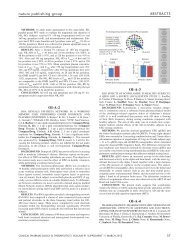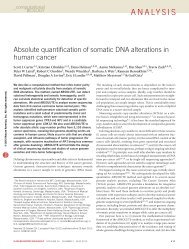open access: Nature Reviews: Key Advances in Medicine
open access: Nature Reviews: Key Advances in Medicine
open access: Nature Reviews: Key Advances in Medicine
You also want an ePaper? Increase the reach of your titles
YUMPU automatically turns print PDFs into web optimized ePapers that Google loves.
CLINICAL ONCOLOGY<br />
OVARIAN CANCER IN 2011<br />
Mutations and non-<strong>in</strong>feriority analyses show<br />
a way forward<br />
Maurie Markman<br />
Highly cl<strong>in</strong>ically relevant ovarian cancer cl<strong>in</strong>ical research <strong>in</strong> 2011 focused on an <strong>in</strong>creased understand<strong>in</strong>g of the<br />
biology of the malignancy, limitations of strategies for early detection and screen<strong>in</strong>g, and the provocative reports of<br />
alternative primary and second-l<strong>in</strong>e management strategies.<br />
Markman, M. Nat. Rev. Cl<strong>in</strong>. Oncol. 9, 69–70 (2012); published onl<strong>in</strong>e 20 December 2011; doi:10.1038/nrcl<strong>in</strong>onc.2011.200<br />
Although there were a number of very <strong>in</strong>terest<strong>in</strong>g<br />
prelim<strong>in</strong>ary reports of thera peutic<br />
advances <strong>in</strong> ovarian cancer <strong>in</strong> 2011 (for<br />
example, bevacizumab <strong>in</strong> the first-l<strong>in</strong>e and<br />
second-l<strong>in</strong>e management of the malignancy,<br />
and olaparib as ma<strong>in</strong>tenance therapy for<br />
high-grade serous cancers), as of the writ<strong>in</strong>g<br />
of this commentary these studies have not<br />
appeared <strong>in</strong> the peer-reviewed oncology literature.<br />
Despite the absence of major advances<br />
<strong>in</strong> the realm of treatment, several papers<br />
published <strong>in</strong> 2011 provide highly cl<strong>in</strong>ically<br />
relevant <strong>in</strong>sight <strong>in</strong>to the management and<br />
unique biology of ovarian cancer.<br />
Perhaps the most important paper <strong>in</strong><br />
2011 was the long-awaited f<strong>in</strong>al report from<br />
the Prostate, Lung, Colorectal and Ovarian<br />
(PLCO) cancer screen<strong>in</strong>g randomized controlled<br />
trial deal<strong>in</strong>g specifically with ovarian<br />
cancer. 1 The study, <strong>in</strong>volv<strong>in</strong>g 78,000 women<br />
with ages rang<strong>in</strong>g from 55 to 74 years, randomly<br />
assigned participants to what was<br />
classified as ‘usual care’ or a rather-<strong>in</strong>tensive<br />
screen<strong>in</strong>g strategy that <strong>in</strong>cluded annual<br />
serum CA125 determ<strong>in</strong>ations and transvag<strong>in</strong>al<br />
ultrasounds. It should be noted that<br />
this study did not specifically target women<br />
identified as be<strong>in</strong>g at ‘high risk’ for the<br />
develop ment of ovarian cancer (for example,<br />
those with a family history of ovarian cancer).<br />
The screen<strong>in</strong>g protocol, undertaken from<br />
November 1993 to July 2001, was performed<br />
at one of 10 centers <strong>in</strong> the USA and the<br />
median follow-up period for the population<br />
was 12.4 years, with patients be<strong>in</strong>g followed<br />
until death or for a maximum of 13 years.<br />
The primary study end po<strong>in</strong>t was the rate<br />
of mortality from ovarian cancer (<strong>in</strong>clud<strong>in</strong>g<br />
primary peritoneal or fallopian tube cancer),<br />
with secondary end po<strong>in</strong>ts of disease <strong>in</strong>cidence<br />
and complications associ ated with<br />
Table 1 | Influence of BRCA1 or BRCA2 on outcome <strong>in</strong> high-grade serous ovarian cancer 6<br />
Mutational status 3-year<br />
PFS (%)<br />
5-year<br />
PFS (%)<br />
the screen<strong>in</strong>g strategy. The study revealed<br />
no difference <strong>in</strong> deaths from ovarian cancer<br />
or other causes between the screen<strong>in</strong>g and<br />
usual-care groups. Specifically, there were<br />
212 cases of ovarian cancer and 118 deaths<br />
from the malignancy <strong>in</strong> the screen<strong>in</strong>g group<br />
versus 176 cases and 100 deaths <strong>in</strong> the rout<strong>in</strong>e-care<br />
population. Furthermore, and of<br />
considerable relevance, 1,080 surgeries were<br />
performed among the 3,285 women with<br />
false-positive screen<strong>in</strong>g tests, and 163 of<br />
these <strong>in</strong>dividuals developed at least a s<strong>in</strong>gle<br />
‘serious complication’. 1<br />
The important data from this screen<strong>in</strong>g<br />
trial provide no support for the rout<strong>in</strong>e use<br />
of annual CA125 determ<strong>in</strong>ations or vag<strong>in</strong>al<br />
ultrasounds for completely asymptomatic<br />
women as a screen<strong>in</strong>g strategy to detect<br />
ovarian cancer. However, it is aga<strong>in</strong> rele vant<br />
to acknowledge that this trial did not specifically<br />
address the issue of screen<strong>in</strong>g a more<br />
high-risk population, nor did it attempt to<br />
def<strong>in</strong>e the utility of these tests <strong>in</strong> the detection<br />
of ovarian cancer <strong>in</strong> <strong>in</strong>divi duals present<strong>in</strong>g<br />
with symptoms (for example, several<br />
weeks of persistent mild abdom<strong>in</strong>al pa<strong>in</strong>).<br />
A study that is somewhat related to the<br />
PLCO trial attempted to address the important<br />
question of whether an earlier diagnosis<br />
of ovarian cancer <strong>in</strong> a sympto matic<br />
<strong>in</strong>dividual might be associated with an<br />
improved outcome. 2 Australian <strong>in</strong>vestigators<br />
HR compared<br />
with WT patients<br />
3-year<br />
OS (%)<br />
5-year<br />
OS (%)<br />
HR compared<br />
with WT patients<br />
BRCA1 mutation 22 13 0.81 (P = 0.44) 64 44 0.76 (P = 0.35)<br />
BRCA2 mutation 44 39 0.40 (P = 0.004) 83 61 0.33 (P = 0.003)<br />
BRCA WT 16 10 – 58 25 –<br />
Abbreviations: HR, hazard ratio; OS, overall survival; PFS, progression-free survival; WT, wild type.<br />
retrospectively exam<strong>in</strong>ed the survival of 1,300<br />
patients with ovarian cancer seen by a physician<br />
with<strong>in</strong> vary<strong>in</strong>g time <strong>in</strong>tervals (55%, 70%<br />
and 92% of the women presented with<strong>in</strong> 1,<br />
2 and 6 months, respectively) from the onset<br />
of their <strong>in</strong>itial symptoms. The <strong>in</strong>vestigators<br />
were unable to f<strong>in</strong>d any difference <strong>in</strong> survival<br />
based on the duration of symptoms before<br />
the time of diagnosis. Importantly, these data<br />
do not support the hypothesis that a somewhat<br />
earlier diagnosis (timel<strong>in</strong>e measured<br />
<strong>in</strong> ‘months’) will be associ ated with superior<br />
ovarian cancer-specific survival, 3 although<br />
the more-timely recognition of the correct<br />
diagnosis will likely result <strong>in</strong> more-rapid <strong>in</strong>itiation<br />
of a management plan that will hopefully<br />
favorably impact serious symptoms and<br />
the <strong>in</strong>dividual’s overall quality of life.<br />
It is well established that mutations <strong>in</strong><br />
BRCA1 and BRCA2 are associated with an<br />
<strong>in</strong>creased lifetime risk for the development<br />
of ovarian cancer. 4 Furthermore, highly<br />
provocative data from a number of ovarian<br />
cancer <strong>in</strong>vestigators have suggested that<br />
with<strong>in</strong> the population of women with documented<br />
advanced-stage ovarian cancer,<br />
patients with BRCA mutations experience<br />
an overall superior survival (compared with<br />
patients with wild-type BRCA), a difference<br />
that is possibly related to <strong>in</strong>creased sensitivity<br />
to plat<strong>in</strong>um-based chemotherapy. 5 In<br />
a most-provocative report, <strong>in</strong>vestigators<br />
KEY ADVANCES IN MEDICINE JANUARY 2012 | S11








